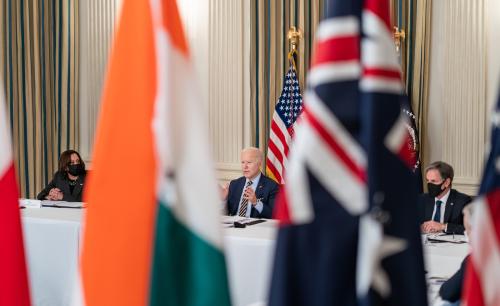It was bound to happen sooner or later: a drone small enough to fit in a backpack, equipped with both a video camera and a warhead so it can be flown, kamikaze style, into the target it is intended to destroy. And indeed, in early September it was announced[1] that the U.S. Army had signed a nearly $5 million contract in June 2011 with California company AeroVironment for the purchase of Switchblade drones. A Switchblade is launched from a tube roughly two feet long, sprouts wings immediately after exiting the tube, and is then controlled by an operator who looks into the long end of a shoebox-shaped viewer[2] displaying video from the drone. It is equipped with an electric motor that is quiet even when running, and that can be switched off to enable a completely silent glide in the final moments of an approach.
In the short term, the Switchblade will provide American forces in Afghanistan and perhaps elsewhere with an important new asymmetrical asset in a conflict that is defined in part by asymmetry. However, the American quasi-monopoly on what are formally called “agile munitions systems”[3] and what others have more descriptively termed “suicide drones”[4] is likely to be short-lived. There will be imitators – crude at first – but inevitably better and better, and while reasonable people can disagree on how long it will take before terrorists, insurgents, and other rogue groups can build or acquire weaponized drones that can be guided by video straight into a target, there’s really no dispute that it is a question of when and not if. The day will come when such drones are available to almost anyone who wants them badly enough.
An accelerating series of events suggests that day may not be far off. There was the 2010 news, for example, of the U.S. government decision to provide unarmed 11-foot-long Shadow drones to Pakistan.[5] Then, there was the August 2011 report that the U.S. Marine Corps is experimenting with arming Shadow drones,[6] meaning that the Pakistanis and others could presumably do so as well. And, as has been widely reported, on September 22, 2011, outgoing Joint Chiefs of Staff Chairman Admiral Mike Mullen testified before the Senate Armed Services Committee that the Haqqani faction of the Taliban “acts as a veritable arm” of Pakistan’s Inter-Services Intelligence agency.[7] While politicians and diplomats in the United States and Pakistan continue their carefully choreographed dance to try to put that genie back in the bottle, the rest of us can give voice to what they almost certainly won’t say publicly: If an armed Shadow drone ends up being used in Afghanistan by the Haqqani network, will anyone really be surprised?
And then there is an international drone market that is, for lack of a better word, exploding. Several dozen different Chinese drone models were on display at the November 2010 Zhuhai air show.[8] Lest there be any doubt regarding Chinese intentions to enter the global market, an official of Xian-based ASN Technology, which claims on its web site to control over 90 percent of the domestic Chinese drone market,[9] said at the Zhuhai show that the company is “interested in exporting” drones, adding “that’s why we’re displaying them here.”[10] Iran is in the mix as well, having unveiled a drone in August 2010 that Iranian President Ahmadinejad managed to describe as both an “ambassador of death” and a “message of peace and friendship” in the same sentence.[11] Iran has long supplied Hezbollah with drones, some of which have been used over Israel.[12] Israel, in turn, has sold drones to Turkey.[13]
Most of the headlines to date have been about large drones. However, it is the smaller drones that are currently attracting the most research and development attention and that pose the most challenging security threat. Small drones are less expensive to purchase, easier to move and hide, and extremely difficult to detect and stop in flight. If the United States can build a drone like the Switchblade, then sooner or later so, too, can Israel, China, Iran, and many other countries. The international arms market is a murky place, and if quiet sales of small, video-capable, armed drones haven’t occurred already, they will soon.
It is against this backdrop that the September 28, 2011 arrest of Boston-area resident Rezwan Ferdaus for allegedly plotting to launch attacks in Washington using a remotely controlled model airplane should really be considered. While the plane that Ferdaus was allegedly planning to use was guided by GPS as opposed to video, technology for capturing video and transmitting it wirelessly is built into almost every smart phone. There are likely many thousands of people in the world with the skills to place this technology on a small drone.
Unfortunately, the alleged Ferdaus plot has been dismissed in some quarters as a joke.[14] But there’s nothing at all laughable about the arrest of someone who, absent being stopped by the FBI, would apparently have been more than happy to carry out a terrorist attack aimed at killing people using a model airplane laden with explosives. And, to scoff at the specifics of his methods is to miss the larger point, much like the Detroit auto industry executives who, according to a perhaps apocryphal story, ridiculed the prototypes shown by Japanese manufacturers at the American auto shows of the mid-twentieth century.
Presumably there are ongoing efforts in the defense departments of the United States and other responsible nations to develop countermeasures against the potential terrorist use of drones that would enable a suicide bomber to avoid suicide. If there is any message in the combination of the early September Switchblade announcement and the late September Ferdaus arrest, which came only a few weeks after the 10th anniversary of a very different use of airplanes as tools of terror, it is that those efforts are more timely and important than ever.
[1] AeroVironment, Inc., “U.S. Army Awards AeroVironment $4.9 Million Contract for Switchblade Agile Munition Systems and Services,” September 1, 2011, http://www.avinc.com/resources/press_release/u.s._army_awards_av_4.9_million_contract_for_switchblade_agile_munition_sys, retrieved September 29, 2011.
[2] MSNBC, “U.S. Army orders its first batch of suicide drones,” September 6, 2011, http://www.msnbc.msn.com/id/44412133/ns/technology_and_science-innovation/t/us-army-orders-its-first-batch-suicide-drones/, retrieved September 29, 2011.
[3] AeroVironment, Inc., op. cit.
[4] MSNBC, op. cit.
[5] United Press International, “Pakistan gets U.S. drones,” January 26, 2010,
http://www.upi.com/Business_News/Security-Industry/2010/01/26/Pakistan-gets-US-drones/UPI-79671264554927/, retrieved September 30, 2011.
[6] Stephen Trimble, “Marine Corps experiments with armed Shadow,” August 17, 2011, http://www.flightglobal.com/articles/2011/08/17/360838/auvsi-marine-corps-experiments-with-armed-shadow.html, retrieved September 30, 2011.
[7] CBS News, “Mullen blames Pakistan intelligence for attack,” September 22, 2011, http://www.cbsnews.com/stories/2011/09/22/ap/cabstatepent/main20110326.shtml, retrieved September 30, 2011.
[8] Jeremy Page, “China’s New Drones Raise Eyebrows,” The Wall Street Journal, November 18, 2010, http://online.wsj.com/article/SB10001424052748703374304575622350604500556.html, retrieved October 4, 2011.
[9] http://www.asngroup.com.cn/english/About.asp?id=8
[10] Jeremy Page, The Wall Street Journal, op. cit.
[11] MSNBC, “Iran unveils ‘ambassador of death’ bomber,” August 23, 2010,
http://www.msnbc.msn.com/id/38804551/ns/world_news-mideast_n_africa/t/iran-unveils-ambassador-death-bomber, retrieved October 4, 2011.
[12] Noah Shachtman, “U.S. Jet Shoots Down Iranian Drone Over Iraq,” Wired Danger Room, March 12, 2009, http://www.wired.com/dangerroom/2009/03/us-jet-shoots-d/, retrieved October 4, 2011.
[13] UPI, “Turkey gets Heron drones,” March 31, 2010, http://www.upi.com/Business_News/Security-Industry/2010/03/31/Turkey-gets-Heron-drones/UPI-27901270064962/, retrieved October 4, 2011.
[14] The Wall Street Journal (AP), “Recent Arrest Puts Model Airplanes on Radar,” September 30, 2011, http://online.wsj.com/article/SB10001424052970204138204576602733596770492.html, retrieved September 30, 2011.


Commentary
Op-edArmchair Kamikaze: What the Latest Generation of Small Armed Drones Means for Antiterrorism
October 6, 2011